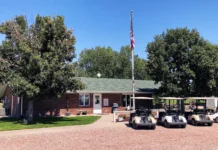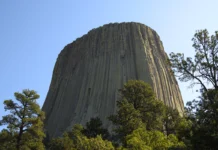| NEBRASKA |
The Great Plains were home to many tribes for countless generations. They lived and hunted along the prairie and sometimes warred with neighboring tribes. In the mid-1800s, they witnessed mass migrations of white men through their territories. The once quiet, barren prairie saw emigrants traveling along overland trails. At the same time, trading posts and military forts began to dot the lands of the Sioux, the Cheyenne, the Arapaho, and other smaller tribes.
This encroachment on their territory worried the tribes. The white man had originally assured the tribes they had no intention to settle. They were merely passing through on their journey west. At first, the tribes stayed away from the trails. It had nothing to do with them and the people were not staying. This quickly changed as the white man’s will began to press down on the tribes’ way of life. Clashes and skirmishes arose. As tensions began to rise, so did calls for a peaceful solution.
Between 1846 and 1851, many parties, including Indian agents, mountain men, fur traders, and missionaries, pushed the U.S. government to negotiate safe passage through American Indian land. Former Superintendent of Indian Affairs Thomas Harvey argued “a trifling compensation for this right of way” would secure a friendship between American Indians and the white man, who were competing for the few resources along the westward trails.
In early 1851, the U.S. Congress authorized a great treaty council with the Plains Indians to find a peaceful solution. Several tribes were invited to Fort Laramie for a meeting on Sept. 1. More than 10,000 Plains Indians (men, women, and children) gathered for the historic signing of the treaty, which detailed the rights and responsibilities of the American Indians and the U.S. Government. It was the largest tribal gathering ever recorded.
Fort Laramie could not support the large group, as well as an estimated 30,000 horses needing a place to forage. The location was moved to Horse Creek, about 30 miles east of Fort Laramie, just east of the present-day Wyoming-Nebraska border. The site is at the mouth of Horse Creek on the North Platte River, near the treaty grounds of the first Red Cloud Agency, which would be established for the Oglala Sioux in 1871.

The location change has led to confusion over the treaty’s name. Regardless of whether it is referred to as the Horse Creek Treaty or the official Fort Laramie Treaty, its outcome was significant and fraught with setbacks.
American Indian camps were also spread out, covering an estimated five miles’ worth of prairie. Despite the desire to live in peace, many tribes had been warring with each other for generations. Giving each tribe its space during the treaty ensured minimal contact and a lesser chance for conflict.
Discussions took some time as issues of supplies and gifts for the tribes did not arrive on time. According to the National Park Service, there was “a cholera outbreak on the steamboat bringing supplies; delays with the 27 supply wagons bringing food to the treaty site; reduced overall funding for the treaty; a military escort cut from 1,000 to 300 men; and, while en route, the Cheyenne attacked and killed two Shoshone warriors.”
During this delay, lists were drawn up of the men in charge in each tribe to make distributing the items, or gifts, easier once they did arise. After the gifts arrived and were distributed, the “long talk” began. The Plains Indians began to express their concerns.

They worried about the increase in emigrants passing through their lands. Their grasslands and feeding grounds were dying from the relentless stomping of animals – cattle, horses, oxen – grinding away at the ground as emigrants traveled west. Wagon wheels cut deep ruts into the ground, destroying vital feeding areas for the tribes’ animals.
Young warriors wanted to fight. Their lands had been violated, and they wanted revenge. Tribal elders hoped a treaty could keep the peace and protect their people and the land. Most of all, the American Indians wanted to be left alone to care for themselves.
The treaty was signed on Sept. 17, 1851. It consisted of eight articles outlining the rights and responsibilities of the tribes and the federal government. It essentially reads, “leave us alone, and we’ll leave you alone.”
American Indians were guaranteed their right to hunt, travel, and live within their ancient boundaries and promised government land protection. The tribes gave the government the right to build forts along the trail and assured the government all travelers on the trail would be provided safe passage.
The tribes had to pay restitution for any wrongdoing of their people against the white man. The head Chief of each nation was to be chosen as a representative of the nation to speak on their behalf to U.S. Government agents. Tribes were also to cease fighting among themselves. The United States was to protect American Indians from U.S. citizens and provide annuities.
The United States was to provide $50,000 per year for 10 years, with the right to continue for an additional five years, “in provisions, merchandise, domestic animals, and agricultural implements, in such proportions as may be deemed best adapted to their condition by the President of the United States, to the distributed in proportion to the population of the aforesaid Indian nations.”
If any tribe violated the conditions, the government could withhold, in whole or part, the items described in Article 7 until the President of the United States changed his mind. The government only ever made one payment.

The Senate signed and ratified the treaty on May 24, 1852, with one major change. The annuity was reduced to $10,000 per year for ten years, subject to the acceptance of the tribes. All tribes except the Crow agreed. According to the National Park Service, “The treaty was never published as ratified in the U. S. Statutes at Large; consequently, there has been some discussion concerning its validity.”
The treaty was in trouble from the day it was signed. Not enough interpreters were available, and no one knew if the tribes understood the treaty, which was written in English.
Gregory Michno wrote in “The Indian Trail of Broken Treaties” that the Lakota almost immediately attacked the Crow, “invaded their lands in what would become Wyoming and Montana, moved in and drove them out. The Cheyennes joined in the attacks in 1853.”
The federal government failed to prevent the migration of gold miners, including along the Bozeman Trail in Wyoming, into American Indian territories in Montana and Colorado. The government did not enforce the treaty to keep out emigrants so Red Cloud, an Oglala Lakota, said he would continue to fight travelers and those on the Army posts until the road was closed.

The U.S. Army established military posts on Sioux lands, a treaty violation, and the Sioux harassed the positions and demanded they be removed.
There were also several massacres, most notably the Grattan Massacre in 1854 and the Sand Creek Massacre in 1864.
Hunkpapa Lakota chief Running Antelope killed four Arikaras in 1853. In 1855, the Assiniboines and the Lakotas fought several times. Tribes had fought before the treaty, but historians attribute this continued fighting to the white settlers and government agents who encroached on Indian lands, killing hundreds of thousands of bison each year.
The reduction of hunting grounds and mass bison killings forced tribes to move into each others’ territories in search of food.

After 1864, the government engaged in warfare against the Sioux, Cheyenne, and Arapaho as the desire for more land increased. The breakdown of the 1851 treaty is often pointed to as a contributing factor to the Indian Wars of the 1870s to the 1890s.
The treaty was renegotiated as the Fort Laramie Treaty of 1868. This new treaty was also doomed to fail as gold was soon found on Sioux land in the Black Hills in present-day South Dakota.
The Horse Creek Treaty Roadside Marker is located one mile west of Morrill, Nebraska, on Highway 26. Horse Creek flows into the North Platte river beyond the treeline about 2 ¾ miles before the marker.
Tribes in attendance: Oglala Sioux, Brule Sioux, Cheyenne, Assiniboin, Mandan, Gros Ventre, Arapahoe, Crow, Hidatsa, Arikara, Snake, Rees. The Shoshone also attended, although they were not formally invited. The Comanche, Kiowa, and Kiowa Apache refused to attend because Ft. Laramie was in Sioux territory.
U.S. Government Representatives in attendance: Thomas Fitzpatrick (Fur trader and Indian Agent to the Sioux) appointed by the President, David D. Mitchell (Superintendent of Indian Affairs at St. Louis) appointed by President Millard Fillmore (1850-1853), Jesuit Father Jean-Pierre De Smet (beloved “black robe” who worked 50 years among the Indians), Jim Bridger (Mountain man and explorer), John C. Fremont (surveyor and explorer), and 300 soldiers.
Treaty Signers: Signing on behalf of the United States were David D. Mitchell and Thomas Fitzpatrick, both appointed and authorized by the President of the United States. Signing for the Indian nations were 21 chiefs, including White Antelope (Cheyenne), Little Owl (Arapaho), Big Robber (Crow), and Conquering Bear (Sioux).
The Assiniboin, Mandan, Gros Ventre, and Arikara chiefs also signed. Although they had traveled more than 400 miles to attend, the Shoshone were not asked to sign because they were not Plains Indians.
| REFERENCES
The information in this article has been compiled from the following:
- Michno, Gregory (2006). “The Indian Trail of Broken Treaties” (PDF). Wild West. p. 40.
- Report to the President by the Indian Peace Commission, January 7, 1868
- Wikipedia: The Treaty of Fort Laramie, 1851
- The Treaty of Fort Laramie, 1851
- The Treaties of Fort Laramie, 1851 and 1868
- Treaties and Broken Promises: 1851-1877
- Treaty of 1851































